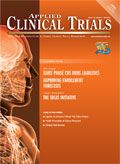Optimizing Efficiency
Applied Clinical Trials
Oncology clinical trials: A case for Russia and Eastern Europe.
A decade ago, many Western biopharmaceutical companies were skeptical and slow to realize the benefits of conducting clinical trials in Russia and Eastern Europe. Now in 2013, our industry is more savvy and experienced in capitalizing on the fast enrollment and high clinical trial quality that this region provides for a variety of disease indications, including oncology.
Oncology landscape in Russia
Russia has experienced a steady increase in the overall prevalence of oncology diseases-2,044 per 100,000 population in 2011, almost a 40% gain over the 2001 rate of 1,506. This growth is due to increasing incidence rates as well as cancer survival rates observed by Russian epidemiologists during the last seven to 10 years.
Russian healthcare is an advanced centralized system with a well-established emergency and primary care (in- and out-patient) network. Generally, patients enter as out-patients and are referred to a multi-profile hospital or specialized institution limited to a single therapeutic area. There is at least one dedicated oncology center in every major Russian region, each serving thousands of patients every year. Many of these rival some of the best clinics in the West in terms of equipment and facilities. There is also a network of 120 oncology dispensaries, which are small- to medium-sized specialized outpatient clinics. Some of these dispensaries also have in-patient care units where patients can stay during the day for procedures and treatment administration. Lastly, Russian oncologists follow medical guidelines issued by the Russian Ministry of Health, which usually are similar to international guidelines. As such, standards of care; specific treatment strategies; and medication choices, including chemotherapy regimens, are similar to those in the West.
Although Russia has a socialized healthcare system with numerous reimbursement programs for patients, not all oncology patients are compensated by the government since not all drugs are on the government formulary, their supply may be limited or inconsistent, or they may be cost-prohibitive for out-of-pocket compensation.
As a result, both patients and physicians see clinical trials as an opportunity to receive and provide access to treatments to which they may otherwise have limited access.
For the last five years, oncology trials have consistently represented approximately 30% of all new clinical trial approvals in Russia (Figure 1).

Are the savings real?
While lower hourly rates and reduced investigator grants in Russia and Eastern Europe are certainly cost-saving factors, this difference is becoming less significant as the number of CROs and competitive trials in the region multiplies and the cost to retain and recruit qualified individuals to perform studies increases accordingly.
The real cost advantage is from the ability to enroll patients up to 20 times faster than in the West, thereby shortening the enrollment timeline and speeding products to market.
In a McKinsey and Lehman Brothers survey of 49 biopharmaceutical executives and chief risk officers, 85% to 95% of those polled cited slow patient recruitment as the main cause of clinical trial delays.
Utilizing average cost per patient in Phase II and III trials from Cutting Edge Information's 2011 report, "Clinical Operations: Benchmarking Per-Patient Costs, Staffing and Adaptive Design" and combining such data with generally accepted assumptions regarding average number of patients and duration of studies (200 patients, 24 months for Phase II studies; 2,000 patients, 48 months for Phase III studies), the operational cost of a delay could be $300,583 to $1,958,333 per month.
In 2001, then BMS president stated: "Every second of delay in a clinical trial costs Bristol-Myers Squibb $17." According to IMS Health, 2011 average daily sales of a top oncology product is $3.8 million; hence, with 86,400 seconds in a day, the lost opportunity cost from the delay of bringing a top oncology drug to market is $44 per each second of delay.
Are the enrollment rates real?
So opportunities for cost savings are real, but are enrollment rates of up to 20 times faster than in the West attainable? ClinStar, recently acquired by PRA, is a geographically-specialized CRO operating in Russia and Eastern Europe since 2000, and has witnessed such rates repeatedly. For a recent global (20 countries) Phase III breast cancer study in 770 patients, ClinStar recruited 318 patients at 25 Eastern European sites, compared to 450+ patients at 150 sites in the rest of the world. By including Russia and Eastern Europe, the sponsor reduced enrollment by 17 months, resulting in significant cost savings.
Are drugs using data from the region receiving regulatory approval?
To date the FDA and EMA have approved numerous products with pivotal data from clinical trials in Russia such as Cymbalta for depression and anxiety, Plavix to prevent blood clotting and future heart attack or stroke, Benlysta for lupus, Yervoy for melanoma, Humira for rheumatoid arthritis, and Xalkori for lung cancer. According to Synergy Research Group's 2011 Orange Paper, 33% of all FDA-approved drugs and 48% of all EMA-approved drugs in 2011 included data from clinical trials conducted in this region.
Conclusion
Russia and Eastern Europe are productive geographies for conducting oncology clinical trials with fast patient enrollment. These trials, with patients and pivotal data from this region, enable biopharmaceutical companies to bring products to market in a cost-effective way while optimizing time and money during the drug development process.
David G. Passov, is Senior Vice President, Eastern Europe at ClinStar, a PRA Company, 1990 N. California Blvd., Suite 608, Walnut Creek, CA, www.praintl.com/clinstar/

Improving Relationships and Diversifying the Site Selection Process
April 17th 2025In this episode of the Applied Clinical Trials Podcast, Liz Beatty, co-founder and chief strategy officer, Inato, discusses a number of topics around site engagement including community-based sites, the role of technology in improving site/sponsor relationships, how increased operational costs are impacting the industry, and more.